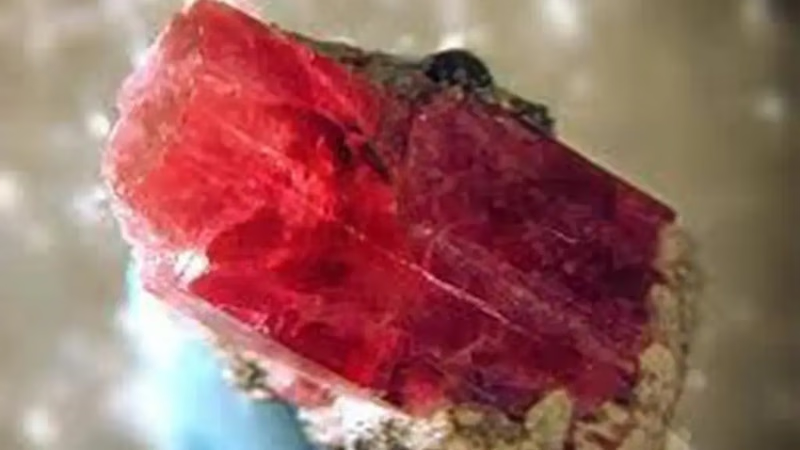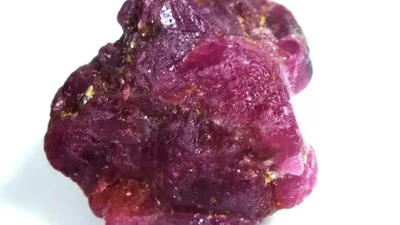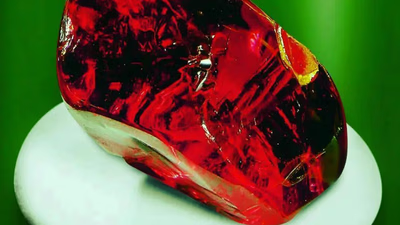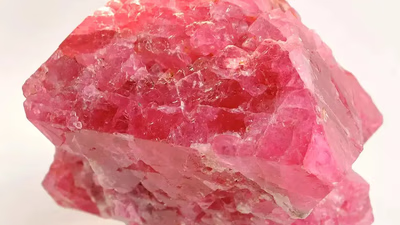
Detecting artificial spinel through visual examination and testing.
A careful visual examination can reveal certain characteristics that may indicate an artificial spinel. Look for any unusual coloring, such as overly saturated or evenly distributed coloration, which can be a sign of artificial treatment. Using a jeweler's loupe or a gemological microscope, closely examine the gemstone for any signs of synthetic growth patterns, noticeable inclusions, or irregularities that are not typically found in natural spinel. Determining the refractive index of the gemstone can help differentiate between natural and synthetic spinel. Natural spinel typically has an RI range of 1.712 to 1.736, while synthetic spinel may have a slightly higher RI.
Gemological laboratories can perform advanced testing techniques, including advanced spectroscopy, X-ray diffraction, or chemical analysis, to conclusively identify synthetic spinel. Some advanced synthetic spinel may closely resemble natural spinel and require sophisticated testing methods to detect. If you suspect that a spinel gemstone may be artificial, it's best to consult a professional gemologist or bring the gemstone to a reputable gemological laboratory for a comprehensive analysis.
- Fluorescence: Natural pearls show strong fluorescence under high-wavelength ultraviolet light, and weak under short-wavelength UV. Fluorescence image of artificial spinel rock under short-wave UV light. However, its synthetic varieties show strong fluorescence during short wavelengths of UV rays and often show light blue, gypsum green or red.
- Microscope: Under the microscope in samples of artificial spinel, traces of flux melting or bubbles in the form of patterns and curves are usually seen due to the way they are made and grown. This is while in natural samples there are many or at least some inclusions.
- Magnets: Natural spinels contain some element of iron and therefore react poorly to the magnet. However, in the synthetic and synthetic spinel samples, there is no reaction due to the way they are made.
- Production in the market: Synthetic spinels with dark red color due to the cost and complexity of the production process are made in small numbers and limited compared to other colors and usually these samples in the market of artificial corundum (ruby) and they are laboratory.
- Light refractive index and specific gravity: Natural spinel has a refractive index of 1.72 to 1.74 for the red spinel and 1.805 when the zinc element is high. The synthetic spinners, on the other hand, have an RI of 1.727 with an error of one thousandth. Also, the specific gravity of the natural type is in the range of 3.58-3.61 and the zinc element in it can increase its specific gravity up to 4.40. This is while synthetic spinels have a specific gravity between 3.64 - 3.63.
- Price: Synthetic spinel rough can be from 300 to 800 dollars per kilogram depending on the quality of the manufacturer. Synthetic spinel gem may be as much as one or two dollars per carat! Price is therefore an important factor in the detection of synthetic spinels. Synthetic samples are very glassy. You should note that the best way to identify the original spinel is to purchase it with a valid gem certificate.
Techniques such as UV-Visible spectroscopy and infrared spectroscopy can provide valuable information about the gemstone's absorption and transmission properties. These tests can help identify any artificial treatments or characteristics that differ from those of natural spinel. Natural spinel usually exhibits weak to no fluorescence under UV light. However, some synthetic spinel may display strong fluorescence, especially if they have been treated. Comparing the gemstone's fluorescence to known natural spinel samples can aid in detection. Synthetic spinel often exhibits growth features, such as curved or elongated gas bubbles, curved growth lines, color zoning, or metallic flux inclusions. These characteristics can be observed using specialized gemological equipment.
-

Spinel and ruby share similar red hues but differ in several key characteristics. Rubies typically exhibit a deeper red color with blue undertones, while spinels can range from orangey-red to pinkish-red. The refractive index (RI) is a crucial factor in distinguishing these gemstones, with rubies having a higher RI. Under UV light, rubies show strong fluorescence, whereas spinels display minimal fluorescence. Accurate identification is essential for gem dealers to provide transparency and ensure fair pricing based on quality and rarity. Historically, the two stones were often confused until the late 18th century when they were classified separately. Chemically, rubies are aluminum oxide corundum, while spinels are magnesium aluminum oxide. Rubies are rarer and more valuable than spinels due to their historical significance and market demand.
The quality of rubies can significantly influence their price, making them one of the most sought-after gemstones. Spinel has gained popularity recently but still holds a lower market value compared to ruby. Both gemstones may contain inclusions; however, rubies often have needle-like inclusions known as rutile silk, while spinels may show octahedral crystal inclusions. In terms of hardness, rubies rank 9 on the Mohs scale compared to spinel"s ranking of 8. "
-

Identifying artificial spinel gemstones involves several methods that highlight their differences from natural counterparts. Visual examination is crucial; look for unusual colors or synthetic growth patterns using a jeweler"s loupe or microscope. The refractive index (RI) is another key indicator, with natural spinel typically ranging from 1. 712 to 1. 736, while synthetic varieties may have a slightly higher RI. Advanced testing techniques, such as spectroscopy and X-ray diffraction, can provide definitive identification of synthetic spinel. Fluorescence tests reveal that natural spinels show weak fluorescence under UV light, whereas synthetic versions often exhibit strong fluorescence in various colors. Additionally, examining the gemstone under a microscope can reveal unique patterns and inclusions indicative of artificial production methods.
Natural spinels react poorly to magnets due to their iron content, while synthetic samples do not react at all. Price can also be a telltale sign; synthetic spinels are generally cheaper than natural ones and often appear glassy in texture. To ensure authenticity, purchasing gemstones with valid gem certificates is recommended. "
-

Spinel prices are influenced by supply and demand dynamics, quality, and market conditions. Limited availability or high demand for specific colors can drive prices up, while excess supply may lead to price drops. The quality of spinel, including color, clarity, size, and cut, plays a crucial role in determining its value. Rare colors and exceptional qualities from renowned sources like Myanmar can command premium prices. Economic factors, geopolitical situations, and global trends also impact market stability and consumer confidence. For instance, fine-quality spinels can range from $200 to $500 per carat for smaller sizes, while larger specimens with rare colors may reach up to $10,000 per carat. The treatment status of spinel affects its desirability; untreated stones are generally more valuable than treated ones. Fashion trends and celebrity endorsements can further influence demand and pricing.
The spinel sales market varies regionally across different segments such as high-end jewelry or wholesale markets. To navigate this complex landscape effectively, consulting industry publications and reputable dealers is essential for accurate pricing assessments.
-

Spinel is a durable gemstone known for its vibrant colors, including red, pink, blue, and black. Often confused with rubies and sapphires, spinel has historical significance, with notable pieces like the "Black Prince"s Ruby" actually being spinels. Its affordability and luxurious appeal make it a popular choice in jewelry. Spinel"s hardness of 8 on the Mohs scale ensures it is suitable for everyday wear, while its excellent transparency enhances its brilliance. Various types of spinel exist, each with unique properties based on their geographic origin. For instance, cinnamon spinel is found in California and Sri Lanka, while green spinel can be confused with emeralds due to their similarities. The market offers a wide range of spinel gemstones that can be cut into various shapes for jewelry making. Spinel"s rich history and diverse color palette contribute to its growing popularity among jewelers and consumers alike. "
-

Spinel is believed to influence both the body and mind, primarily through metaphysical practices rather than scientific validation. Advocates claim that spinel can enhance physical vitality, support recovery, and boost energy levels. It is also thought to aid in emotional healing by helping individuals release past traumas and negative emotions. Specific benefits attributed to black spinel include promoting clarity of mind, reducing headaches, and enhancing sexual power. Additionally, it is said to improve heart health and prevent various diseases. On a mental level, spinel is associated with clarity, focus, and creativity, helping users overcome confusion and enhance problem-solving skills. Different colors of spinel are believed to have unique effects; for example, red spinel may increase passion while blue spinel promotes calmness. Furthermore, spinel is regarded as a protective stone that shields against negativity and fosters emotional balance.
While many people find personal value in these beliefs about spinel"s properties, it is crucial to remember that they should not replace professional medical advice or treatment. "
-

Myanmar, Sri Lanka, Thailand, and Tajikistan are key players in the global spinel market. The Mogok region in Myanmar is particularly famous for high-quality spinel, including the renowned "Mogok Ruby. " Sri Lanka"s Ratnapura district is another significant source, known for its diverse color range. Thailand"s Bo Rai and Chanthaburi regions contribute to the gemstone trade as well. Spinel mining has also gained traction in Vietnam since the 1990s, especially around Luc Yen. Tanzania is notable for its vibrant red-pink spinels found in Morogoro County and Tunduru region. The Badakhshan Spinel mine in Tajikistan holds historical significance and produces both red and pink spinels. The availability of spinel can fluctuate due to new discoveries or depletion of existing deposits, making it essential to consult current sources for accurate information on mining operations.
Countries like Afghanistan, Nepal, Australia, and Madagascar also have notable spinel deposits. Overall, the global landscape of spinel mining is dynamic and influenced by various regional factors.






